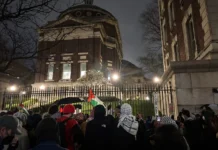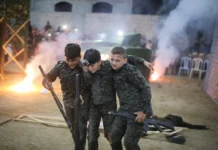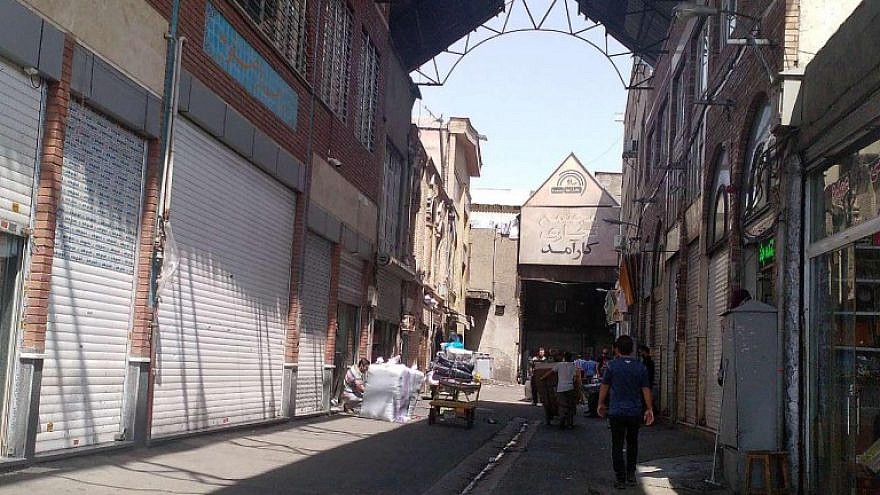Since June 24, 2018, protests have been taking place in several main cities in Iran. This time, the protesters were mainly comprised of traders from the Bazaar in Tehran and other commercial locations throughout Iran. The bazzaris initially protested the sharp and fast fall in the value of the Iranian currency, the rial, in dollar terms, the freeze in Iran’s economic activity, and the rising cost of imported goods.
The decline of the Iranian economy gathered speed, and it is expected to suffer even more due to President Trump’s May 8, 2018, announcement that the United States was pulling out of the nuclear deal, the re-imposition of sanctions on Iran, and the notice of several large international corporations that they intend to stop doing business with Iran and/or not sign any new contracts.

The social networks were flooded with hashtags from bazaaris calling for more people to join the national strike #اعتصابات_سراسری).). The hashtag ( #ساعت_6 ) widely appeared. It gave the time to start demonstrating at 6:00 PM, when people should swarm into the streets. It was presented in different variations, with clear symbols and slogans of the opponents of the regime.4 Demonstrators chanting “Death to Khamenei” and “Death to Palestine” (#مرگ_بر_فلسطین), in defiance of Iran’s foreign adventures at the expense of the Iranian people, were uploaded to social network accounts. At the same time, Iranian virtual platforms also dealt with unemployment, economic hardships, and the ongoing water crisis that has hit different areas in the country.
Conservatives Use the Protests to Taunt the Government
Conspicuously, the conservative media outlets, which usually don’t cover anti-government protests, have been following the traders’ protests. Apparently, it is so they can taunt the government and its economic failings. The secretary-general of the traders’ guild of the Tehran Bazaar, Ahmad Karimi Isfahani, pointed an accusing finger at the government and said, “We expect President Rouhani and his government to admit that the steps they have taken connected with anything to do with the Iranian economy were a mistake” and that the protest began due to a lack of economic stability, the deepening economic crisis, and the apathy of the government toward the population and the traders.5
The Iranian security forces, and primarily the units for dispersing protests, were deployed in the streets of Tehran in order to contain the events, but until June 26, they generally refrained from using force to disperse the demonstrators and relied on teargas grenades.

The government, for its part, acted to bring down the value of the dollar as compared with local currency and to deal with foreign currency offenders. The governor of the Central Bank of the Islamic Bank of Iran, Valiollah Seyf, announced that Iran would open a “parallel/secondary market” for trading in foreign currencies at fixed rates (42,000 rials = 1 U.S. dollar) to help the private sector import goods valued in dollars and prevent wild currency rates being set by uncertified brokers.6 In April, President Rouhani first imposed this rate to prevent any further fall in the value of the rial but without any success, and the dollar rate reached 85,000 rials or more.
During the current crisis, President Rouhani instructed authorities to reveal the names of those importers who have received foreign currency at subsidized rates but sold their merchandises at free-market prices. Rouhani blamed U.S. sanctions for the crisis at a gathering in Tehran on June 26, 1018, and insisted that there is no shortage of currency and goods in the market.7 Supreme National Security Council (SNSC) Secretary Ali Shamkhani, said that profiteer groups (mainly in the mobile phone market) and currency smugglers would be monitored.8 Judiciary chief, Ayatollah Sadeq Amoli Larijani, lambasted those who are “disrupting the economy” by funneling their huge assets into foreign currency, threatening they will be designated as “corrupted on earth (punishable by death).” Amoli urged the police to identify those who disrupt the market, saying they commit “treason against the system and the nation.”9 The Majlis‘ National Security and Foreign Policy Committee discussed the recent economic fluctuation during its latest meeting on June 25, 2018.10
The Iranian media has dealt with the economic crisis in depth, as well as the solutions offered by the government. Essentially, much of the criticism was directed at President Rouhani who, “to the surprise of the public,” chose to spend his vacation at the luxury Tochal mountain resort in north Tehran in the middle of an economic crisis, while the traders and public opinion are waiting for a solution to the economic problems and price rises.
Even the president’s western-style apparel has been subject to criticism. For example, he was seen wearing Western-brand apparel – an Under Armour sweatshirt and a Puma hat.11, 12 The headline of the Vatan Emrooz newspaper on June 25, 2018, shows the president dressed in western sports clothing, and it shrieks, “The economy is on the verge of the abyss, and Rouhani is in Tochal.”

The Situation Is Only Getting Worse
Economic stabilization in Iran is not yet visible on the horizon. The protest of the bazaar traders is just one example of the many different demonstrations that have taken place throughout Iran in recent times (truck drivers, teachers, laborers, and protests about pollution and the lack of water). This process was accelerated when President Trump decided to pull out of the nuclear deal with Iran, and all the immediate ramifications of this upon the Iranian economy occurred. The regime’s recent steps toward what Khamenei termed in 2017 the “Year of Economy of Resistance” or “resistive economy” to circumvent sanctions are likely to have a negative effect on the citizens of Iran with more bans on imported goods.

A Perfect Storm?
At the same time, the protest by the traders at the bazaar – the beating heart of Iran’s economy, at least in the past – is unique and a warning light for the Iranian regime. The bazaar protest originally was not against the Islamic government. It was focused upon Iran’s growing and genuine economic hardships due to the sanctions on the country that are already affecting it. The protest is authentic, and it reflects the difficulties of the traders at the bazaar (mainly those who buy in dollars) and the Iranian citizen, who finds it hard to buy goods due to rising prices. At the same time, the protest did not occur in a vacuum, and it adds to the general feeling of discontent – not only at the economic level – with the Islamic regime (and not only against the government as the conservatives try to portray).
Senior hardline government officials and written and conservative broadcast media outlets have been quick to use the bazaar protest against the Rouhani government and its economic shortcomings. Some continue to blame the government for the agreement on nuclear negotiations and its temporary compromise on Iran’s nuclear capabilities. Khamenei’s advisor, Yahya Rahim Safavi, a Revolutionary Guard commander and presently the Supreme Leader’s hardline adviser on security affairs, has written in the past that the country would be better without any government (an expression that was later removed from the conservative media.)13
The bazaaris are not necessarily aligned with the sworn opponents of the regime, despite the continued erosion of their position by the Revolutionary Guards’ substantial economic conglomerate. Meanwhile, the economy of the Revolutionary Guard is strengthening through smuggling and the eviction of the established, traditional class of the traders. At the same time, the bazaar has been part of every revolution that has occurred in Iran, and given the appropriate opportunity, the emergence of a united leadership, and a clerical support base, it may join a new revolution.
Right now, a perfect storm does not appear to be on the horizon. As the sanctions increase and go into effect and the economic crisis worsens, circumstances may be created that could undermine the current stability of the regime. As opposed to the “gentle” pushing out of the traders’ protests, the regime would not hesitate to use all of its powers of suppression, such as they did at the events of the “Green Protest” in 2009, led by Mir-Hossein Mousavi and Mehdi Karroubi, who are presently still under house arrest.
IDF Lt.-Col. (ret.) Michael (Mickey) Segall, an expert on strategic issues with a focus on Iran, terrorism, and the Middle East, is a senior analyst at the Jerusalem Center for Public Affairs and at Alcyon Risk Advisors.
* * *
Notes
1 https://www.farsnews.com/photo/13970404001167/%da%a9%d8%a7%d8%a8%db%8c%d9%86%d9%87-%d8%aa%d9%88-%da%a9%d8%a7%d8%a8%db%8c%d9%86%d9%87
2 https://www.voanews.com/a/tehran-protests-extend-into-second-day/4456374.html, http://www.irna.ir/fa/News/82953777
3 https://twitter.com/rh9S8MFgUFzBjsv/status/1011344572029591553
4 https://twitter.com/princccccess/status/1009787677028245504
5 https://www.khabaronline.ir/detail/785976/Economy/commerce
6 http://www.tehrantimes.com/news/424762/Iran-to-create-secondary-currency-market-by-next-week
7 http://english.almanar.com.lb/528651
8 https://tinyurl.com/Tasnim-2606
9 http://www.tehrantimes.com/news/424826/Iran-s-top-judge-vows-severe-punishment-for-economic-disruption
10 https://ar.mehrnews.com/news/1885172/%D9%84%D8%AC%D9%86%D8%A9-%D8%A7%D9%84%D8%A7%D9%85%D9%86-%D8%A7%D9%84%D9%82%D9%88%D9%85%D9%8A-%D8%AA%D8%A8%D8%AD%D8%AB-%D8%A7%D8%B3%D8%A8%D8%A7%D8%A8-%D8%A7%D9%84%D8%AA%D9%82%D9%84%D8%A8%D8%A7%D8%AA-%D8%A7%D9%84%D8%A7%D9%82%D8%AA%D8%B5%D8%A7%D8%AF%D9%8A%D8%A9
11 https://tinyurl.com/TASNIMUnder256
12 http://www.vatanemrooz.ir/newspaper/page/2469
13 http://www.ghatreh.com/news/nn43153358/%D9%BE%D8%A7%D8%B3%D8%AE-%D8%AF%D9%86%D8%AF%D8%A7%D9%86-%D8%B4%DA%A9%D9%86-%D8%B3%D8%B1%D9%84%D8%B4%DA%A9%D8%B1-%D8%B1%D8%AD%DB%8C%D9%85-%D8%B5%D9%81%D9%88%DB%8C-%D8%B1%D8%AC%D8%B2%D8%AE%D9%88%D8%A7%D9%86%DB%8C-%D8%B3%D8%B9%D9%88%D8%AF%DB%8C


























